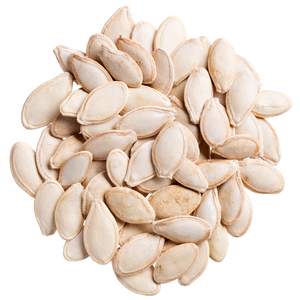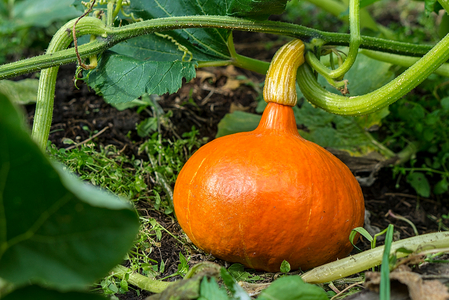Profile
The pumpkin(Cucurbita pepo) originally comes from the tropical regions of South America. It came to Europe after the discovery of America and has spread worldwide. Not only among the South American natives, but also in Europe, the pumpkin was not only popular as a food but also as a remedy from the very beginning.
Utilisation

Due to its high water content (around 90 per cent), pumpkin is considered a low-calorie vegetable. Varieties with orange-coloured flesh contain significant amounts of carotenoids, which are considered to be vitamin A precursors. Pumpkin seeds also have a high content of fats (containing up to 64 per cent linoleic acid), proteins, carbohydrates, δ-7-phytosterols, tocopherols (vitamin E), many different amino acids, carotenoids and minerals (e.g. selenium). As antioxidants, the tocopherols help to stabilise the pumpkin seed oil, giving it a comparatively long shelf life. Ornamental pumpkins and bitter-tasting pumpkin fruits should not be eaten as they contain cucurbitacins and can lead to poisoning.
Pumpkins are also used medicinally. Traditional Chinese medicine attributes diuretic, detoxifying and dehydrating effects to it, as well as a soothing effect on coughs and bronchial asthma.
Pumpkin seeds(Cucurbitae peponis semen) have been used for centuries to treat bladder and prostate problems. The ripe, dried seeds of the pumpkin plant contain a range of ingredients (including phytosterols, lignans and amino acids) that are said to have a favourable effect on the typical symptoms associated with an enlarged prostate, irritable bladder or bladder weakness. They alleviate urination problems by strengthening the bladder muscles and positively influencing the sphincter. This effect is complemented by anti-inflammatory properties. In pharmacological studies, individual ingredients and extracts have been found to influence the prostaglandin metabolism, have anti-androgenic effects and have anti-inflammatory effects. However, the mechanisms of action are not fully understood.
Pumpkin seeds are used as medicinal products in powder form or as extracts in the form of capsules and tablets as well as pumpkin seed oil in capsules. Combination preparations with other medicinal plants are also available. Pumpkin seeds are not used as a tea infusion.
Botany

The common pumpkin, also known as the garden pumpkin, belongs to the pumpkin family(Cucurbitacea). It is an annual plant with creeping and climbing stems up to eight metres long, which are rough-haired and alternate with large, palmately lobed leaves. The golden-yellow, stalked flowers sit in the leaf axils. They bloom between June and August.
The fruits of the pumpkin are among the largest in the plant world and can weigh up to 25kg. Botanically speaking, they are berries. The flesh is yellow, watery and mucilaginous, with a large number of flat, oval, greenish or light brown seeds, which are known as pumpkin seeds. Among other things, the nutty-smelling green pumpkin oil and the phytotherapeutically used plant extracts are obtained from the seeds. The whole, dried, ripe seeds are used for these.
Service
The preservation of diversity is very important to us, which is why we store around 5,400 samples of seeds and plants in our gene bank. With the gene bank for agricultural crops, medicinal and aromatic plants, we are making a significant contribution to the preservation of biodiversity.
Last updated: 25.09.2025
automatically translated